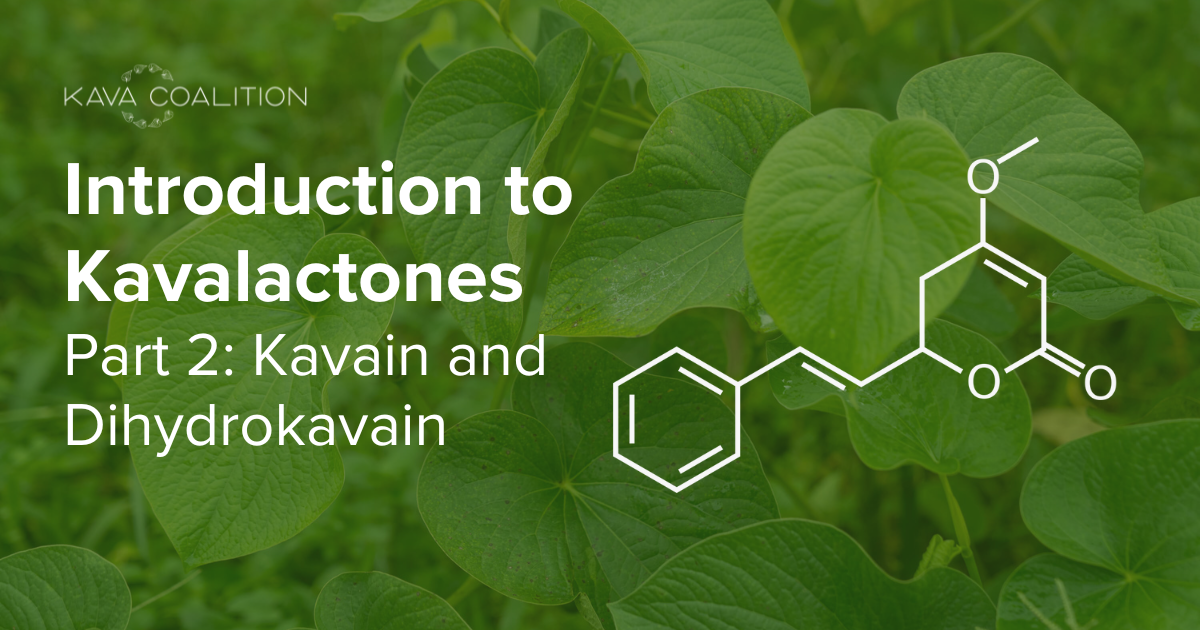Introduction to Kavalactones — Part 2: Kavain and Dihydrokavain
This article provides an examination of the scientific literature concerning kava and kavalactones. It is important to note that this article is not intended to serve as an endorsement for diagnosing, treating, preventing, or curing any disease.
Now that kavalactones as a class of compounds have been introduced to our readers, the individual science of each of the six major kavalactones will be discussed starting with kavain and dihydrokavain.
Kavain is one of the six major kavalactones found in the roots of the kava (Piper methysticum) plant and has been studied to determine how it contributes to the overall effects of kava consumption. In vitro study of kavain demonstrated that the compound inhibits monoamine oxidases (MAOs). MAOs are key metabolic enzymes for neurotransmitters and inhibitors of MAOs are often used in treatment of neuropsychiatric and neurodegenerative disorders. Some of the major “feel good” hormones like serotonin and dopamine are broken down by MAOs, so compounds that inhibit MAOs do not allow for the breakdown of these hormones. Kavain was found to be a potent inhibitor of MAO-B and a moderate inhibitor of MAO-A which may account for some of the anxiolytic effects of kava (1).
Preclinical (animal) studies have demonstrated that kavain acts as a positive allosteric modulator of gamma-aminobutyric acid type A (GABA-A) receptors, leading to enhanced GABAergic neurotransmission and consequent anxiolytic and sedative effects (2,3). Additionally, in rat models, kavain has been shown to inhibit the reuptake of norepinephrine and dopamine, contributing to its effects on mood (4).
Furthermore, emerging research suggests that kavain may possess neuroprotective properties, offering potential beneficial applications in neurodegenerative disorders such as Parkinson's disease and Alzheimer's disease. Studies have shown that kavain exhibits antioxidant and anti-inflammatory activities, which could maintain health and help mitigate neuronal damage and neuroinflammation associated with these conditions (5).
Dihydrokavain is another compound found in kava roots that is structurally similar to kavain. The only difference between the two is the loss of a double bond at the C7 position.
As a structural analog of kavain, dihydrokavain has been found to share similar pharmacological effects to those of kavain. Like kavain, dihydrokavain enhances GABAergic neurotransmission and produces anxiolytic and sedative effects (3). Additionally, dihydrokavain has been reported to possess anti-inflammatory properties, suggesting potential benefits in inflammatory conditions such as arthritis and inflammatory bowel disease (6).
Moreover, dihydrokavain may support health functions and possible offer neuroprotective effects similar to kavain, potentially providing therapeutic benefits in neurodegenerative disorders. By modulating neurotransmitter systems and attenuating neuroinflammation, dihydrokavain could help preserve healthy neuronal function and slow disease progression in conditions such as Parkinson's disease and multiple sclerosis.
Both kavain and dihydrokavain have also been shown to produce analgesia through non-opioid mediated pathways in mice (7).
References:
1. Prinsloo, D., van Dyk, S., Petzer, A., and Petzer, J.P. 2019. Monoamine Oxidase Inhibition by Kavalactones from Kava (Piper Methysticum). Planta Med 85 (14/15): 1136-1142. doi:10.1055/a-1008-9491.
2. Kretzschmar R, Meyer FP, Strohmeier B, Gollnhofer O. Kava pyrones exert effects on neuronal transmission and transmembrane cation currents similar to established mood stabilizers – a review. Phytomedicine. 2019;55:18-27.
3. Singh YN. Kava: An overview. J Ethnopharmacol. 2002;80(2-3):85-97.
4. Baum SS, Hill R, Rommelspacher H. Effect of kava extract and individual kavapyrones on neurotransmitter levels in the nucleus accumbens of rats. Prog Neuropsychopharmacol Biol Psychiatry. 1998;22(7):1105-20.
5. Lobbens ES, Cogger VC, Le Couteur DG, Hilmer SN. Kava hepatotoxicity: a clinical survey and critical analysis of 26 suspected cases. Eur J Gastroenterol Hepatol. 2010;22(10):1235-40.
6. Teschke R, Schwarzenboeck A, Hennermann KH. Kava hepatotoxicity: comparison of aqueous, ethanolic, acetonic kava extracts and kava-herbs mixtures. J Ethnopharmacol. 2011;133(3):822-31.
7. Jamieson DD, Duffield PH. The antinociceptive actions of kava components in mice. Clin Exp Pharmacol Physiol. 1990 Jul;17(7):495-507. doi: 10.1111/j.1440-1681.1990.tb01349.x. PMID: 2401103.



